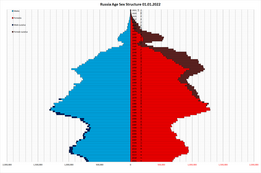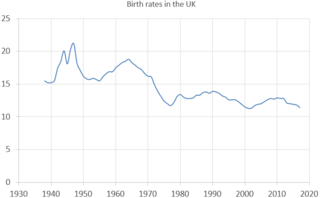
Demographic features of the population of Cambodia include population density, ethnicity, education level, health of the populace, economic status, religious affiliations and other aspects of the population.

Ireland had an estimated population of 5,281,600 as of 1 April 2023.
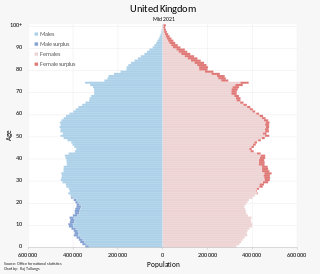
The population of the United Kingdom was estimated at almost 67.6 million people in 2022. It is the 21st most populated country in the world and has a population density of 279 people per square kilometre, with England having significantly greater density than Wales, Scotland, and Northern Ireland. Almost a third of the population lives in south east England, which is predominantly urban and suburban, with about 9 million in the capital city, London, whose population density is just over 5,200 per square kilometre.
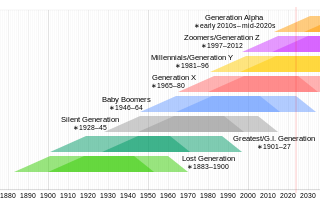
Baby boomers, often shortened to boomers, are the demographic cohort following the Silent Generation and preceding Generation X. The generation is often defined as people born from 1946 to 1964 during the mid-20th century baby boom. The dates, the demographic context, and the cultural identifiers may vary by country. Most baby boomers are the children of either the Greatest Generation or the Silent Generation, and are often parents of Gen Xers and Millennials.

The demography of France is monitored by the Institut national d'études démographiques (INED) and the Institut national de la statistique et des études économiques (INSEE). As of 1 January 2021, 65,250,000 people lived in Metropolitan France, while 2,785,000 lived in overseas France, for a total of 68,035,000 inhabitants in the French Republic.

The population of Australia is estimated to be 27,174,900 as of 4 May 2024. Australia is the 56th most populous country in the world and the most populous Oceanian country. Its population is concentrated mainly in urban areas, particularly on the Eastern, South Eastern and Southern seaboards, and is expected to exceed 30 million by 2029.

The United States had an official estimated resident population of 334,914,895 on July 1, 2023, according to the U.S. Census Bureau. This figure includes the 50 states and the District of Columbia but excludes the population of five unincorporated U.S. territories as well as several minor island possessions. The United States is the third most populous country in the world, and the most populous in the Americas and the Western Hemisphere. The Census Bureau showed a population increase of 0.4% for the twelve-month period ending in July 2022, below the world average annual rate of 0.9%. The total fertility rate in the United States estimated for 2022 is 1.665 children per woman, which is below the replacement fertility rate of approximately 2.1.

Millennials, also known as Generation Y, are the demographic cohort following Generation X and preceding Generation Z. Researchers and popular media use the early 1980s as starting birth years and the mid-1990s to early 2000s as ending birth years, with the generation typically being defined as people born from 1981 to 1996. Most Millennials are the children of Baby Boomers and older Generation X. In turn Millennials are often the parents of Generation Alpha.

The United States is a country primarily located in North America. Demographics of the United States concern matters of population density, ethnicity, education level, health of the populace, economic status, religious affiliations, and other aspects regarding the population.

Birth rate, also known as natality, is the total number of live human births per 1,000 population for a given period divided by the length of the period in years. The number of live births is normally taken from a universal registration system for births; population counts from a census, and estimation through specialized demographic techniques. The birth rate is used to calculate population growth. The estimated average population may be taken as the mid-year population.

The Total Fertility Rate (TFR) of a population is the average number of children that are born to a woman over her lifetime if:
- they were to experience the exact current age-specific fertility rates (ASFRs) through their lifetime
- and they were to live from birth until the end of their reproductive life.
Population decline, also known as depopulation, is a reduction in a human population size. Throughout history, Earth's total human population has continued to grow; however, current projections suggest that this long-term trend of steady population growth may be coming to an end.
Demographic dividend, as defined by the United Nations Population Fund (UNFPA), is "the economic growth potential that can result from shifts in a population’s age structure, mainly when the share of the working-age population is larger than the non-working-age share of the population ". In other words, it is "a boost in economic productivity that occurs when there are growing numbers of people in the workforce relative to the number of dependents". UNFPA stated that "a country with both increasing numbers of young people and declining fertility has the potential to reap a demographic dividend."

The middle of the 20th century was marked by a significant and persistent increase in fertility rates in many countries of the world, especially in the Western world. The term baby boom is often used to refer to this particular boom, generally considered to have started immediately after World War II, although some demographers place it earlier or during the war. This terminology led to those born during this baby boom being nicknamed the baby boomer generation.

The population of Taiwan is approximately 23.35 million as of April 2023.

The ageing of Europe, also known as the greying of Europe, is a demographic phenomenon in Europe characterised by a decrease in fertility, a decrease in mortality rate, and a higher life expectancy among European populations. Low birth rates and higher life expectancy contribute to the transformation of Europe's population pyramid shape. The most significant change is the transition towards a much older population structure, resulting in a decrease in the proportion of the working age while the number of the retired population increases. The total number of the older population is projected to increase greatly within the coming decades, with rising proportions of the post-war baby-boom generations reaching retirement. This will cause a high burden on the working age population as they provide for the increasing number of the older population.
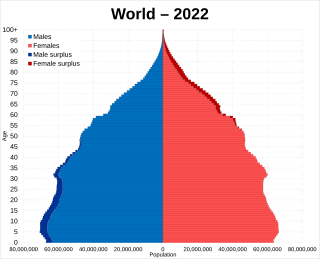
Earth has a human population of over 8 billion as of 2024, with an overall population density of 50 people per km2. Nearly 60% of the world's population lives in Asia, with almost 2.8 billion in the countries of China and India combined. The percentage shares of China, India and rest of South Asia of the world population have remained at similar levels for the last few thousand years of recorded history. The world's literacy rate has increased dramatically in the last 40 years, from 66.7% in 1979 to 86.3% today. Lower literacy levels are mostly attributable to poverty. Lower literacy rates are found mostly in South Asia and Sub-Saharan Africa.

Australia has an ageing demographic. The proportion of the Australian population aged 65 and over was 15% in 2017, a trend which is expected to continue to grow. It is estimated that by 2057 older people will account for 22% of the Australian population which translates to 8.8 million people. This increase in elderly population is due to what is known as The Australian Baby Boom. This period refers to the post-war era in which total fertility rates (TFR) were approximately 3.0, resulting in 4.19 million births recorded. This number exceeded the number of births in Australia from the previous 20 years in which there were 1.63 million births, and the proceeding 20 years in when 2.56 million births were recorded. The baby boom children will be celebrating their 65th birthday between 2011 and 2030, the age which is referred to as elderly.

In recent decades, the fertility rate of the United States has declined below replacement level, prompting projections of an aging population and workforce, as is already happening elsewhere in the developed world and some developing countries. The decline has been most noticeable since after the Great Recession of the late 2000s. Nevertheless, the rate of aging in the United States remains slower than that seen in many other countries, including some developing ones, giving the nation a significant competitive advantage. Unintentional pregnancies have become less common; in particular, teenage pregnancies have dropped to record lows.
Generation Alpha is a social cohort born between the early 2010s and mid 2020s. The birth years of Generation Alpha have seen a decline in birth rates, especially in the developed world.


